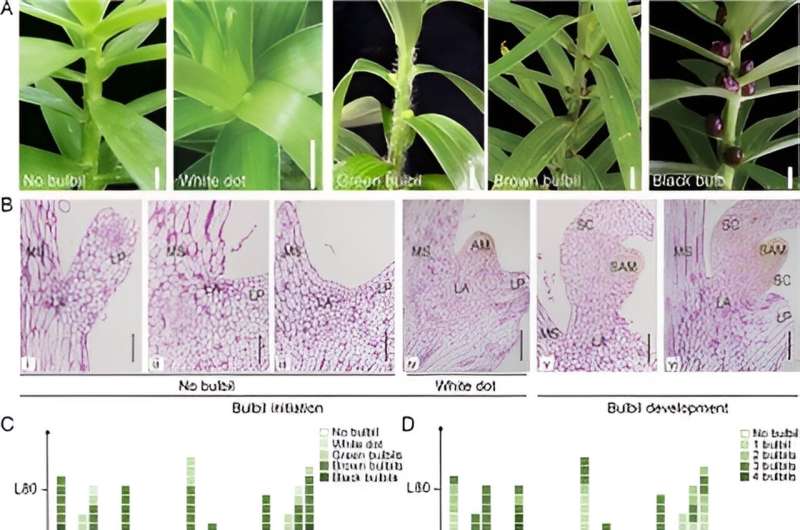
A study reveals how auxin and sucrose metabolism regulate bulbil initiation in Lilium lancifolium. By manipulating auxin levels and examining key sucrose metabolism genes, researchers found that low auxin concentrations enhance bulbil formation. This discovery offers promising implications for horticulture, providing new strategies to improve bulb propagation through hormonal and metabolic pathways.
Bulbils in lilies serve as crucial vegetative reproductive organs, ensuring plant survival and propagation. The initiation of these structures, however, is not well-understood, particularly the roles of hormonal and metabolic pathways. Auxin, a plant hormone, is known to regulate various growth processes, including lateral organ formation. Sucrose metabolism provides essential energy and substrates for plant development.
Despite these known functions, the interplay between auxin and sucrose metabolism in bulbil initiation remains unclear. Based on these challenges, it is necessary to conduct in-depth research to understand the mechanisms underlying bulbil initiation.
Researchers from the Beijing Academy of Agriculture and Forestry Sciences and China Agricultural University published a study in Horticulture Research on February 23, 2024, revealing the mechanisms by which auxin regulates bulbil initiation in Lilium lancifolium. The study investigates how auxin levels, manipulated through treatments and gene silencing, affect sucrose metabolism and subsequently bulbil formation.
The study focused on understanding the role of auxin in bulbil initiation in Lilium lancifolium. Exogenous treatments with indole-3-acetic acid (IAA) and the auxin transport inhibitor N-1-naphthylphthalamic acid (NPA) were applied to manipulate auxin levels in leaf axils. Results showed that low auxin concentrations, achieved by NPA treatment or silencing of auxin biosynthesis genes LlYUC6 and LlTAR1, significantly enhanced bulbil formation.
Histological observations confirmed that bulbil initiation coincided with lower auxin levels and increased expression of sucrose metabolism genes LlSusy1 and LlCWIN2. These genes were found to facilitate sucrose degradation, leading to higher glucose levels that promote bulbil initiation.
Additionally, the study identified the transcription factor LlbHLH35, which directly activates LlSusy1 in response to auxin signaling, thus linking auxin content to sucrose metabolism. This research highlights the critical role of the auxin-sucrose module in regulating bulbil initiation, providing a potential strategy to enhance lily propagation through hormonal and metabolic manipulation.
Dr. Jian Wu, a lead researcher in the study, commented, “Our findings reveal a sophisticated interaction between auxin and sucrose metabolism in lily bulbil initiation. By understanding and manipulating these pathways, we can potentially improve vegetative propagation in lilies and other horticultural crops.”
The study’s insights have major implications for horticulture. Manipulating auxin levels through chemicals or genetics can enhance bulbil formation and improve lily propagation efficiency. This could lead to new techniques that optimize bulb yield and quality, benefiting growers and breeders. Understanding these controls may also enhance propagation methods and yields in other crops.
More information:
Yin Xin et al, Auxin regulates bulbil initiation by mediating sucrose metabolism in Lilium lancifolium, Horticulture Research (2024). DOI: 10.1093/hr/uhae054
Citation:
Unraveling the auxin-sucrose nexus in Lily bulbil formation (2024, June 13)
retrieved 13 June 2024
from https://phys.org/news/2024-06-unraveling-auxin-sucrose-nexus-lily.html
This document is subject to copyright. Apart from any fair dealing for the purpose of private study or research, no
part may be reproduced without the written permission. The content is provided for information purposes only.







